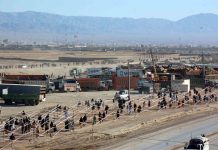Peshawar: At nearly seventy years, the wait has been agonizingly long but Sardar Santok Singh is happy that it is over. Standing outside the Gurdwara Bhai Beeba Singh where he has come to pray, Singh beams as he talks about reopening of the 300 hundred years old Sikh temple in Peshawar, joy infusing his words and his large luminous eyes.
“Worship at a place where our forefathers used to pray is a tremendous moment,” says Santok Singh, a young man in his thirties. Around him, young and aging men in colourful turbans reflect his happiness in their bearded faces, clearly overwhelmed by a moment that is both historic and sacred for the Sikhs in Peshawar.
The long-silent halls and alcoves of Gurdwara Bhai Beeba Singh have resounded with prayers and hymns since it opened on March 31 after nearly 70 years for the Sikh community to pray here again. The temple was abandoned after 1947 when communal violence in the wake of Partition forced the Sikh community to migrate to cities in the Punjab. Some migrated to the tribal areas along the border of Afghanistan, settling down in the tribal districts of Khyber, Kurram and Orakzai among the Pashtun tribes, adopting clan sobriquets and identities overtime.
“The situation is much different now as interfaith harmony among Muslims and Sikhs has increased over the years,” said Manmohan Singh, an ageing Sikh patriarch among the cheerful crowd that had gathered at the Gurdwara for prayers.
All these years, the Gurdwara with an imposing façade has stayed under the Auqaf Department that is responsible for the care of worship places. While Auqaf’s oversight kept it from falling into the hands of encroachers, it did fall into disrepair due to lack of use and maintenance. For a long time, the local people claimed that it wasn’t even a gurdwara because nobody ever saw it used as one. The Sikh community, however, had been pushing for its restoration and opening all the time. After the Auqaf department decided to open it, Rs 1.1 million was spent on repairs and renovation of the temple, according to Asif Khan, Deputy Administrator Evacuee Trust Property Board (ETPB).
Muhammad Siddique-ul-Farooq, Chairman of the Evacuee Trust Property Board (ETPB), formally handed over the Gurdwara to the community on March 31st in the presence of Sardar Soran Singh, Minister for Minorities and Special Assistant to Chief Minister for Minority Affairs Khyber Pakhtunkhwa.
“The reopening of the Gurdwara that has been close for almost 7 decades symbolises tolerance and interfaith harmony among the people of different faiths,” Siddique told News Lens Pakistan.
The Gurdwara located in Jogiwara Mohalla, an old Sikh neighbourhood in the Hashtnagri Bazaar in Peshawar, was built by the celebrated Sikh King Ranjeet Singh. Founder of the Sikh empire in the subcontinent, Ranjeet Singh ruled from Lahore in the Punjab. His empire lasted nearly 50 years – from 1799 to 1849. The Sikh rule ended in the Punjab when it was annexed in 1849 by the British colonial rulers in India.
The Sikh community in the Peshawar dates back to the days of Maharaja Ranjeet Singh whose empire included the Khyber Pakhtunkwa province.
Manmohan Singh said that he was happy that ardas (spiritual prayers) and recitation of Guru Granth – the holy book of the Sikhs – had resumed in a building that had been lying vacant for decades.
“I would be happy if this historical building served not only as a gurdwara but as a vocational centre for Sikh and non-Sikh women as in the past,” he said.
Shafqat Ara, a Muslim woman of 82, had been living in the Gurdwara compound since 1954. She rented a small room in the compound from the ETPB and had been looking after the Gurdwara building all along. Ara was the first head of the Vocational Training Department in the province who established 14 technical education schools for girls when she was in service.
“I am happy that the Gurdwara has been opened to the Sikh community again,” said Ara while talking to News Lens Pakistan. “There would be hustle and bustle again on the premises of the building and I would be no more alone.”
Soran Singh, the provincial minister who represents the minorities, said as a Sikh he was grateful to the federal and provincial Government for their efforts to restore the Gurdwara to its former self.
“Today the dream of Quaid-e-Azam Muhammad Ali Jinnah to make this country a safe place for minorities has turned into reality,” says Soran Singh.
However, Mohammad Ali, a bookseller in the front of Gurdwara expressed concern about the safety of the place. He hoped that opening of the temple would not spark any “untoward situation” in the area.
“My only concern after the reopening of the Gurdwara is about security,” said Ali.
Violence and terror attacks against minorities are common in Pakistan. The last such attack happened on 27 March 2016 when a suicide bomber blew himself up in a park in Lahore, killing 72 people including 26 children. The bombing was aimed at the Christian community celebrating Easter.
In the wake of the attack, Pakistan army announced an operation in the Punjab against militants and Taliban who had claimed responsibility for the attack.



